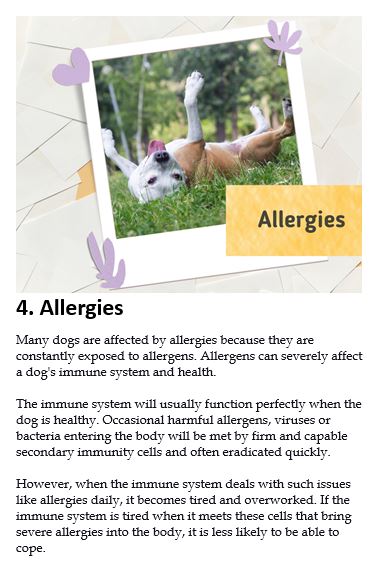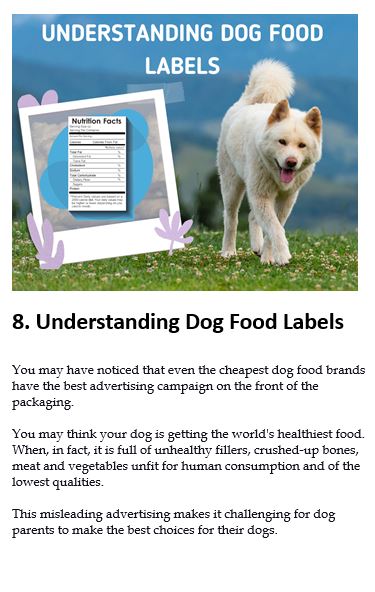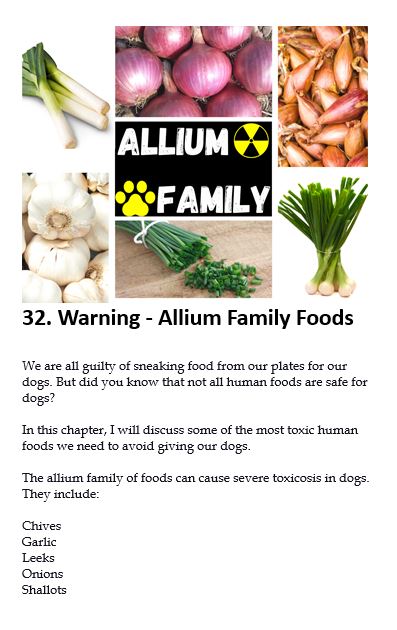If your dog has sore skin, it’s crucial to take measures to prevent the skin sore from becoming infected. Silver sulfadiazine cream is one product that can help with this. Silver sulfadiazine cream is a topical antibiotic that can help to kill bacteria and prevent infection.
Silver Sulfadiazine Cream
Dr Charles L Fox Jr, a bacteriologist, created Silver sulfadiazine cream in 1969, mainly for 2nd and 3rd-degree burns. It became a big success due to its high effectiveness qualities.
Silver Sulfadiazine Cream 1% is a topical antibacterial cream that you can safely apply to the external skin to prevent burns or skin sores from becoming infected. Without treatment, these can quickly become infected with dangerous bacteria or yeast. Silver Sulfadiazine Cream heals and prevents them from leading to severe infections.
Now we know a bit more about it, let’s run through the best practices when applying this cream to your dog’s skin.
Are you wondering why your dog gets these sores in the first place? Some skin sores are well known, like cat scratches. However, there are some other reasons why that you can avoid.
I will also go through why your dog may get these sores in the first place and what you can do to help your dog not get them in the first place to prevent turning to tropical treatments again.
However, tropical treatments are needed temporarily if your dog shows signs of sores. As a caring pet parent, you must apply cream to prevent further infection.
Never use Silver Sulfadiazine Cream in or around your dogs:
- Ears
- Eyes
- Mouth
- Nose
You can use it safely on your dogs:
- Back
- Base of tail
- Belly
- Bum
- Head
- Legs
- Neck
- Paws
- Tail
The amount to use
You can use the Silver Sulfadiazine Cream in the areas listed above. Apply a small amount and work it in if possible. If it is too sore, dab the area gently with the cream. Do not put lots of cream on because your dog might lick it off.
Perfect for:
- Burns
- Cat scratches
- Flea bites
- Over itching
- Paw minor cuts
- Paw sores
When to apply Silver Sulfadiazine Cream
Apply it to a clean wound with the correct amount and in safe areas. Watching your dog the first few times you use it would be best. If the first time using the cream, don’t apply it at night in case they react or start to lick it off.
Safety Advice For The Dog Parents
When using the cream on your dog, wearing gloves and washing your hands is best. Be careful not to get it in your eyes.
Type of wounds safe for:
- Surface wounds
Type of wounds not safe for:
The below wounds should be looked at by a veterinarian as soon as possible without delay and not treated with creams at home.
- Deep open wounds
- Bleeding wounds
How Often To apply
Twice a day unless your vet tells you to do it differently. If in doubt, speak with your veterinarian.
Pregnant And Nursing Dogs
You must not apply the cream on a pregnant or nursing dog. You should speak to your veterinarian about their sores. A vet can help you find a safer option for your pregnant dog and puppies.
When Not to Use Silver Sulfadiazine Cream
- If your dog is pregnant or nursing
- Puppies younger than six months old
- Suspected allergies against sulphonamides, sulfur or sulfa
Silver Sulfadiazine Cream Allergy Signs
- Coughing
- Diarrhoea
- Hair loss
- Itching
- Non-healing
- Rash
- Runny eyes
- Runny nose
- Sneezing
- Thinning of fur
- Tummy pain
- Wheezing
Stop using the cream and contact your veterinarian for any signs. They can suggest different options for your dog.
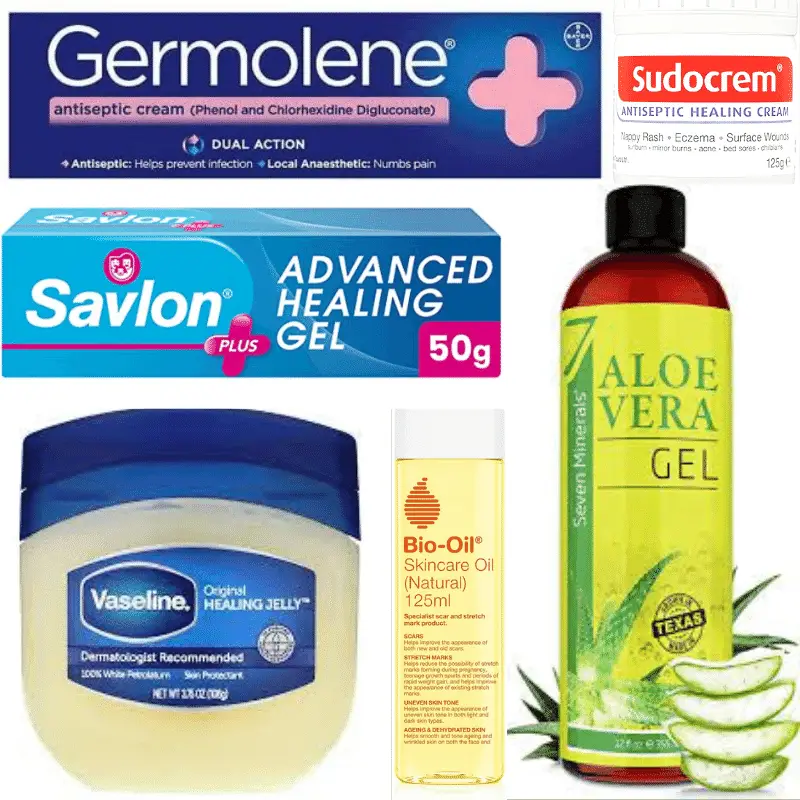
Check these other products to see if they are safe for dogs.
Preventing Skin Sores In Dogs
Some skin sores are out of our control, like getting into scraps with the neighbour’s cat, diving under a fence, and getting a scratch from the fencing. However, some unexplained dog sores and hot spots can be avoided or reduced to a minimum.
The first line of defence in dogs is the skin. When a dog’s immune system struggles to keep up with its other roles in its body, the skin and fur are often overlooked so that the immune system can concentrate on other vital processes, like fighting bad cells and renewing cells.
One way to check that your dog’s immune system is given the best chance to be at its strongest is by checking what food you give your dog.
Good nutrition is vital for our dogs. So by providing them with the very best, the immune system doesn’t need to choose between what should come first and what should be left out.
Designed Specifically for Dogs, Worry-Free and Safe
RenaSan First Aid+ Spray is a revolutionary antiseptic clinically proven to kill 99.9999% of germs in seconds. Approved for veterinary use worldwide, this pain-free, sting-free and skin-friendly spray contains only water, salt and hypochlorous – no sodium hypochlorite (bleach), preservatives, alcohol or nasty chemicals.
RenaSan is safe to use in and around the mouth, ears, nose and paws of pets and animals, as well as for skin, eye and ear disinfection, on insect bites and for hard and soft surface sanitation.
Produced by the world leader in Hypochlorous technology, you can trust RenaSan to give you the safest, most effective and most stable Hypochlorous on the market.
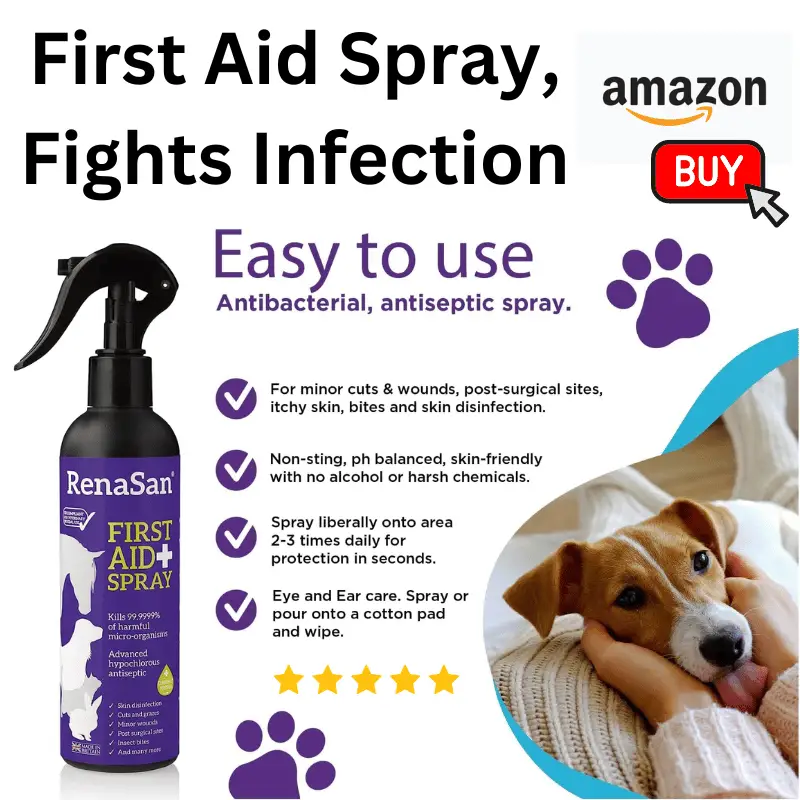
Check your dog food label, not the front but the back of the package. If you see long words you can hardly pronounce, it’s likely full of preservatives and chemicals. Also, check for a bone meal ingredient and ensure the food isn’t full of this. Bone meal is crushed up bones. Usually, the first five ingredients listed are the main bulk of it. Check the below for the bad and good ingredients.
Consider changing your dog’s food if you find more than the bad. Also, be aware that dogs, such as wheat or chicken, can have skin sores from allergies. Try grain-free, hypoallergenic food and switch current meat or fish varieties to count out allergies.
Allergies keep the immune system fighting areas where they should tackle other body processes, leaving the skin and fur fragile.
The power that diet has on the skin is undoubtedly underestimated! Nutrients like vitamin A, B complex, C, Zinc and Essential fatty acids are all essential for healthy skin and fur.
If you feed your dog kibble, please read this article. I wrote it to give you a better understanding of kibble.
Bad Ingredients
Bone Meal: Bones ground up from any animal to provide low-quality calcium and filler.
Derivatives: Can be any part of any animal, including beak, bones, or feet added. Sometimes it can state the type of animal. However, it will still be any part of that specific animal.
Fat: Animal fat is often sprayed on dog food to make it tastier and more appealing. The fat comes from the cooking process of the animal, and when it is heated to an extremely high temperature, and as the grease floats to the top, it’s gathered up for use. Dogs need fat in their diet—however, it is questionable if this is the best option.
Sugar Beet: This is used as a fibre in dog foods. The sugar beet has the sugar removed, leaving only a form of fibre substance behind. However, this type of fibre may not be the best fibre a dog could have.
Grains: A lot of dogs are allergic to grains like wheat. Rice is, however, still used and considered safe.
Vegetable Derivatives: Vegetables from many possible vegetable sources. These can be either good or bad—human vegetable preparation waste.
Meal: Bones and other non-meat parts of an animal are grounded in powder form and added to dog food or treats. The meal is classed as cheap fillers and of poor-quality calcium.
Good Ingredients
Pure Meat: Meat taken from a specific animal. Such as beef, chicken, or duck. The best quality cuts of meat. The dog brands with pure or fresh meat labelled on the back are remarkably high quality.
Botanicals, Herbs or Plants: These are added health enhancements for your dog. If this is listed on the label, it means excellent quality dog food with your dog’s health at the forefront of their company.
Vegetables: These are the finest of vegetables.
Supplements
If you can’t change your dog’s food for whatever reason, perhaps it won’t eat anything else, or it’s convenient for you and your family, I suggest a daily multivitamin.
Protien Allergry Foods
Hydrolysed Animal Protein: Animal protein is broken down into its most minor form, so a dog’s body does not recognise it as protein, and it is used in hypoallergenic food. The protein can be from any animal.
Food Boost For Skin Health In Dogs
You can give a dog sardines once a week. Sardines will be good for their skin health, and they can eat them with regular food as a topper or on their own.
Two of the essential fats that a dog can benefit significantly from are the following:
Eicosapentaenoic Acid (EPA) is a vital anti-inflammatory fatty acid
Docosahexaenoic Acid (DHA) is necessary for a dog’s eye health, skin, and brain.
You can get these exceptional fats in a single can of sardines.
Do not feed your dog sardines if they suffer from pancreatitis.
Shampoos
Harsh shampoos may also be the culprit of your dog’s unexplained sores. I suggest getting a natural shampoo for sensitive skin.
Conclusion
The above is all you need when treating your dog’s sores using Silver Sulfadiazine Cream. Remember, if the skin sores are unexplained, try my suggestion to prevent future sores from occurring.
Good Luck and Happy Dog Parenting!
Any success stories I would love to hear from you they will certainly make my day that I have been able to help. Or, if you would like my book, it’s available to purchase, which talks about the canine immune system and how best to make it the most robust possible through food.
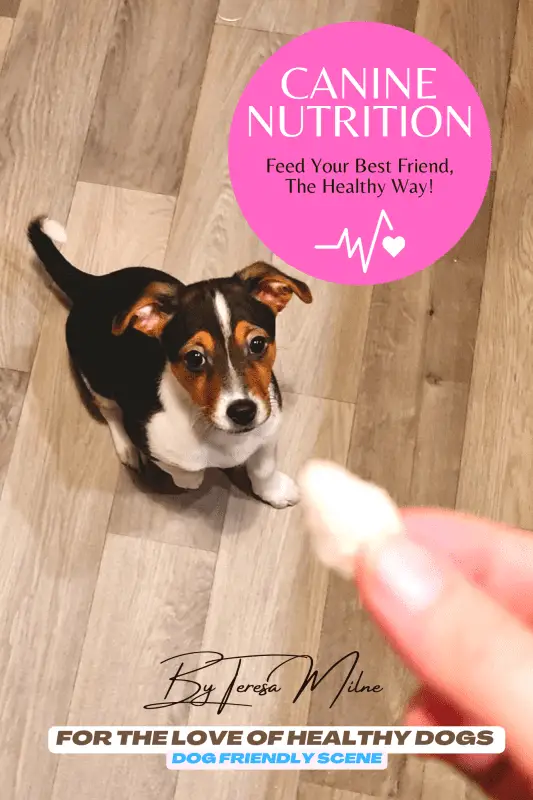
Get My Book!
Author: Teresa Milne
Cram-Packed With Information That Matters
Want to know more about dogs and how to look after them nutritionally? If so, I have written a book of my top and most important advice for any dog owner, whether you are new to dog parenting or an existing one. My book will arm you with the tools of knowledge so you can make the best choices for your dog’s health.
The ultimate aim is healthy, happy dogs that live longer with their owners!
- 118 pages long and 43 chapters
- Release date: July 2022
- Written by Canine Nutritionist Educator
- A proud dog mum
Available to buy on Amazon

